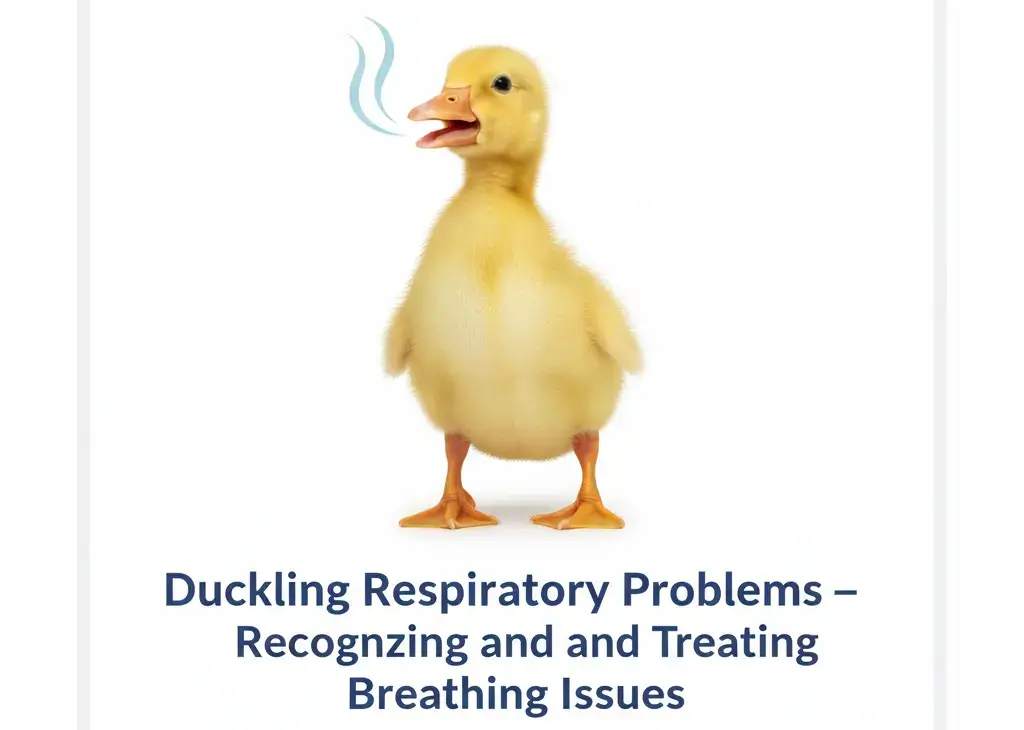Tiny breaths tell big stories. I watch my ducklings closely, because Duckling Respiratory Problems can move fast. A small wheeze today can be a major issue tomorrow. I keep an eye on breath, eyes, and energy, and I act early. In this guide, I share clear steps you can use today: early signs, likely causes, simple at‑home care, when to call a vet, and prevention tips that protect the whole brood.
Safety first. If a duckling looks sick, I isolate it, keep it warm and hydrated, and call a vet for severe signs like gasping or a blue tint to the bill. Quick, calm care saves lives.
Spot the Signs Early: How I Identify Duckling Respiratory Problems
Early detection changes outcomes. I scan for changes several times a day, because small birds can crash in hours.
I start with breathing. Normal breathing is quiet and steady. The chest moves gently. The bill stays closed at rest. Any noise gets my attention. I also check eyes and nares for crust, bubbles, or discharge. Clear eyes, clean nostrils, and dry feathers tell me the airways are calm.
Next, I look at behavior. A lively duckling eats, peeps, and explores. A sick one sits apart, peeps less, or tucks its head often. I compare each bird to its hatch mates. One that lags behind for a day or two raises a flag.
I scan the brooder too. Wet bedding, dusty shavings, or a sharp ammonia smell can inflame tiny lungs. I fix the environment right away, then reassess the ducklings in a calm, warm space.
I rule out heat stress when I see panting. If the brooder is hot, I cool it. If the duckling still pants in a comfortable zone, I treat it like an airway issue.
I write down what I see. Time, signs, feed changes, bedding changes, and any new birds. Good notes help a vet move faster.
Noisy or Open-Mouth Breathing
Normal duckling breathing is quiet, with the bill closed and the body relaxed. Warning signs include open-mouth breathing at rest, tail bobbing with each breath, or sounds like wheezing, clicking, or crackles. Stress or heat can cause panting, so I check the brooder temperature first. If the noise continues in a calm, warm space, I treat it as a red flag and isolate the duckling.
Nasal Mucus, Sneezing, and Watery Eyes
I inspect the nares for dried crust, bubbles, or wetness. Repeated sneezing, stained feathers on the face, or sticky, half-closed eyes point to infection or dusty bedding. Thick yellow or green discharge often means bacteria are involved. A clear, thin drip can follow irritation from dust or ammonia, especially if bedding is wet or old. I fix the environment quickly, then keep observing.
Lethargy, Poor Growth, or Lameness
Respiratory infections hit more than lungs. Toxins, fever, and poor oxygen can drain the whole body. Affected ducklings sit apart, peep less, eat slowly, and fall behind in size. They may wobble or show lameness. I compare to hatch mates over 24 to 48 hours. If one falls behind, I act. My quick checklist:
- Appetite down
- Water intake down
- Chills easily
- Unsteady gait
Red Flags That Need a Vet Now
Some signs need help right away:
- Gasping or choking motions
- Blue or purple tint to the bill or legs
- Head or eye swelling
- Thick pus or foul-smelling discharge
- Heavy breathing while resting
- Rapid deaths in the group
Sudden high fevers or many birds sick at once can point to a serious outbreak, including viral disease. Isolate, warm, hydrate, then call a vet.
Read this also: Why Is My Duck Coughing?
Causes, Treatment, and Prevention: What Works for Duckling Respiratory Problems
Trouble starts in the air, water, bedding, or with an unseen germ. My plan follows a simple flow: fix the environment, support the duckling, get a diagnosis when needed, and keep the brooder clean going forward.
When I face stubborn coughs or wheezes, I review credible resources. Cornell’s Duck Research Lab details signs of aspergillosis and other issues, which helps me make better decisions with my vet. See their guidance on Duck Health Care for context.
Common Causes: Bacteria, Mold, Viruses, and Ammonia
- Bacteria: Riemerella and other bacteria can enter by air or small cuts, then spread. Birds may show fever, thick discharge, and fast decline.
- Fungi: Aspergillosis comes from inhaled mold spores, often from damp, moldy bedding or feed. It causes nodules in lungs and air sacs, with gasping and weakness. Cornell outlines these classic signs in their duck health resources.
- Viruses: Some viruses, including avian influenza, can move fast and hit hard. Group illness, high death rates, and severe breathing issues call for immediate veterinary help and local reporting rules.
- Irritants: Dust, smoke, or ammonia from wet bedding inflames the airways and sets the stage for infection. Cold, drafty brooders and poor ventilation make everything worse.
Safe First Aid at Home
Here is what I do at the first sign:
- Isolate the duckling to reduce stress and spread.
- Warm to 85 to 90°F for very young ducklings, then adjust by age and behavior. If they huddle, they are cold. If they spread out and pant, it is too hot.
- Offer clean water with duck-safe electrolytes. Refresh often.
- Gently clear clogged nares with warm saline and a soft cotton swab, never pushing deep.
- Improve air quality now. Replace wet bedding, choose low-dust material, and add gentle airflow without drafts. I avoid steam rooms, since heat and humidity can exhaust ducklings. I favor mild humidity with steady warmth.
If signs stay mild and improve within a day after these steps, I keep monitoring and adjusting care.
When a Vet Prescribes Meds
A vet may take swabs to identify the cause, then select treatment. For bacteria, a vet may prescribe antibiotics such as enrofloxacin (Baytril) where legal, or other drugs based on culture and sensitivity. I never use leftover meds or guess the dose. For aspergillosis, antifungals and strong supportive care are needed, but outcomes can be poor, so quick action matters. For suspected avian influenza or fast group spread, I follow my vet and local rules.
If birds are raised for meat, I follow withdrawal times for any drugs used. Laws differ by country and by drug. Food safety matters.
Brooder Fixes That Prevent Flare-Ups
I try to make the brooder do most of the health work for me:
- Keep bedding dry and fluffy. Remove wet spots twice daily.
- Discard moldy feed. Clean feeders and waterers every day.
- Use good ventilation without direct drafts.
- Avoid cedar shavings. Pick low-dust pine or similar.
- Control dust. Sift shavings and avoid powdery materials.
- Separate age groups to reduce spread.
- Quarantine new birds before mixing.
- Clean with a proven disinfectant, such as Interkokask, as directed.
- Set brooder temperature by age and behavior, not a guess.
I also log daily weight and behavior. Small changes show up in the numbers before my eyes catch them.
Read this also: Treat bumblefoot in ducks
Conclusion
Healthy ducklings need clean air, quick care, and early action. Small signs, like soft wheezes or watery eyes, point to bigger issues you can fix fast. Trust your gut when a duckling seems off, and act the same day. Keep a simple care log, set a cleaning routine, and store feed dry. With steady steps and a vet’s help when needed, most ducklings bounce back, and your whole flock breathes easier. Stay watchful, and protect their tiny lungs.
FAQs
Can ducklings catch colds from humans?
No. Human colds do not infect ducklings. I still wash hands, change shoes, and put on a clean shirt before handling them. Some human germs can add stress or introduce other risks. Good hygiene protects fragile lungs.
What bedding is safest for duckling lungs?
I use kiln-dried pine shavings with low dust. I skip cedar and dusty straw. I change wet spots right away and keep the air moving, not drafty. Dry, clean bedding lowers ammonia and keeps airways calm.
Is Baytril safe for ducklings?
Only a vet can decide. Enrofloxacin, sold as Baytril, is used in some places for serious bacterial infections. Laws vary by country, and food safety rules apply. I follow my vet’s dose and withdrawal guidance and never self-dose.
How do I tell aspergillosis from a simple chill?
A chill improves with warmth and rest. Aspergillosis brings steady breathing trouble, weakness, and poor response to warmth. A history of damp bedding or moldy feed raises concern. A vet exam and tests give clear answers.
Should I separate sick ducklings from the brood?
Yes. I isolate the sick bird to limit spread and stress. I keep it warm, offer fluids, and watch the rest of the flock. I handle sick birds last, then change gloves and wash hands before touching healthy birds.

Hello! I’m Ibrahim, the owner and writer of this blog. I run a chicken farm with 160 chickens, and I’ve gained a lot of knowledge about raising and caring for them. Now, I want to share my insights and experiences with you to help you in chicken keeping.

